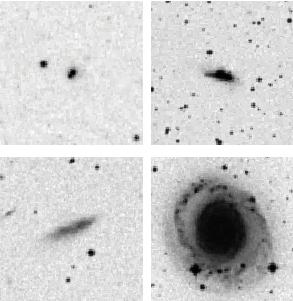


4.3 Low Surface Brightness Galaxies
A low surface brightness galaxy (LSBG) is, as the name implies, a galaxy with surface brightness fainter than µB,0 = 23 mag/arcsec2 (the central B-band surface brightness). This class spans from tiny dwarfs, sometimes similar to dSph galaxies, to luminous giants like Malin 1 (Bothun et al. 1987). The latter are in general not metal-poor by our standards, and will not be considered here. Instead, we will be interested in the LSBGs with low integrated luminosities (the dwarf LSBGs). Many dEs could in fact classify as LSBG, but we will reserve this name for late type galaxies, often gas rich, keeping in mind that dEs in general have comparable surface brightness. Low surface brightness gas poor galaxies (as observed e.g. in Virgo, e.g. Binggeli et al. 1984) will be covered by the dE class. Dwarf irregulars with low surface brightness, will be included in our LSBG class. The appearance of a typical LSBG on the digitised sky survey is shown in Fig. 2.

|
Figure 2. Some galaxies as seen in the
Digitized Sky Survey (obtained from Sky View).
All images have dimension 3 x 3 arcminutes, north is up east is left.
Top left: The ``prototypical'' BCG IZw18, distance (D) = 10 Mpc,
MB = -14, Z |
The LSBGs pose a severe problem for the general understanding of the galaxy population. This is because their nature make them difficult to detect with most techniques that have been applied to survey the galaxy content of the Universe. A striking example is the not too distant giant (MB = - 21.1) Malin 2 (Bothun et al. 1990). With an integrated apparent magnitude of 14.65 it is bright enough to be included in most galaxy catalogues. The fact that it is not illustrates that despite the claims, galaxy catalogues are not magnitude limited, but rather surface brightness limited (cf. Disney and Phillipps 1983). This has the consequence that our view of the LSBG population is largely incomplete, and since dwarfs tend to be of low surface brightness, it is evident that we are lacking many local metal-poor LSBGs and dEs. See e.g. Bothun et al. (1997) for a general discussion on the problems of finding LSBGs. In view of these difficulties, the true space density of LSBGs is badly known, although some recent progress has been made.
Van der Hulst et
al. (1993),
studying H I properties of LSBGs, found
that while the gas mass and gas mass fractions are high, the column density of
H I is low due to very extended H I morphologies. The neutral gas densities are
found to be lower
than the empirical threshold for star formation found for normal high
surface brightness galaxies
(Kennicutt 1989)
explaining the low star formation rates. A similar study was performed by
van Zee et al. (1997a)
who compared dwarf LSBGs with ``normal'' gas-rich dwarfs,
finding no qualitative difference however and noting that both types
were equally inefficient star formers.
De Blok et al. (1996)
found further support for low gas densities as compared to
normal high surface brightness galaxies. Moreover the gas mass fraction
is higher in LSBGs than other types of galaxies
when measured with respect to the absolute blue luminosity (typically
MHI / LB = 1, in solar units)
or the dynamical mass
(McGaugh and de Blok
1997).
They suggest that the total mass density of a galaxy regulates its rate
of evolution. The dynamical
masses are of the order of 1010 M and the H I masses
an order of magnitude smaller.
It is likely that LSBGs have experienced continuous star formation at
low rate
(Bergvall &
Rönnback 1994).
Bell et al. (1999)
suggest that the principal
difference between blue and redder
LSBGs is the e-folding timescale for star formation.
The general conclusion seems to be that LSBGs are gas rich and
unevolved, both chemically and
photometrically, which may be related to their low mass densities.
and the H I masses
an order of magnitude smaller.
It is likely that LSBGs have experienced continuous star formation at
low rate
(Bergvall &
Rönnback 1994).
Bell et al. (1999)
suggest that the principal
difference between blue and redder
LSBGs is the e-folding timescale for star formation.
The general conclusion seems to be that LSBGs are gas rich and
unevolved, both chemically and
photometrically, which may be related to their low mass densities.
In view of their probably high space density and large gas mass fractions, the LSBGs constitute an important fuel reservoir for star formation in the Universe. Gas in LSBGs can be made accessible to other galaxies e.g. in collisions. Likewise, if the extended low density gas somehow can be forced to collapse, LSBGs may be sites of future starbursts. The possible physical relations with other galaxies will be addressed in Sect. 7.2. Moreover, there have been suggestions that LSBGs may be responsible for some of the metal line absorption systems seen in QSO spectra (e.g. Phillipps et al. 1993).